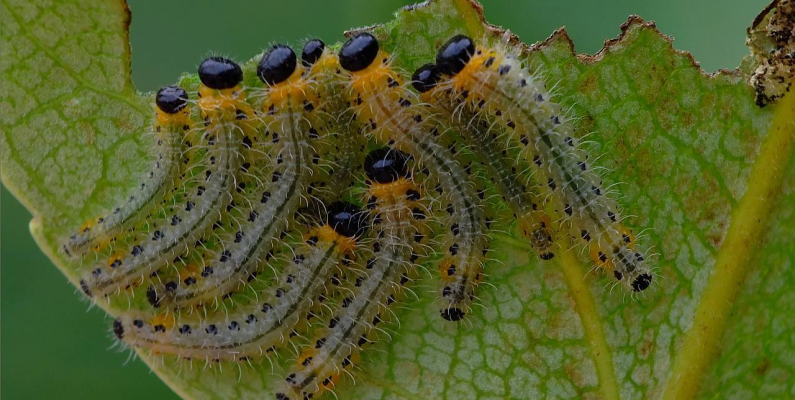
In January 2019, while checking gypsy moth monitoring traps in Abbotsford, Dunedin, a different unwanted insect, a single larva of the poplar sawfly, (Cladius grandis (Hymenoptera: Tenthredinidae)) was discovered by the Ministry for Primary Industries. This was the first time this species has been recorded in New Zealand, and Otago Museum are interested to hear from you if see any of these foreign wasps or their larvae.
To start with, what is a sawfly?
A sawfly is a wasp from the order Hymenoptera. It is part of the suborder Symphyta. The common name for these wasps comes from the saw-like egg laying ovipositor that female wasps use for cutting into plants to lay their eggs. Sawflies are also known as wood wasps. The primary difference between sawflies and ants, bees, and wasps is that the ‘waist’ between the abdomen and the thorax is much thicker on a sawfly.
What does the poplar sawfly look like?
The eggs of the poplar sawfly are laid in clusters in a double row along the side of the leaf petiole .
The larvae can be up to 16 mm long, and are yellow with two lateral rows of black spots and whitish hairs. The head is blackish-brown, except for some yellow spots at the front. The larvae are very distinctive when they are feeding. They are usually seen lying side by side on the underside of the leaf and start feeding at the tip and work their way backwards until the reach the bottom edge of the leaf. At this point they will usually migrate to another leaf and start again. The larvae can easily be confused with the willow sawfly, so if you see something, please take a photo in order for it to be verified. They pupate in sheltered spots in the bark of trees, or at the base of the tree.
The adult poplar sawfly is 6 – 9 mm long, is a reddish-orange colour. The head and saddle of the thorax is black, and the wings are a yellow, hyaline colour that is iridescent with reddish veins.

Image: Adult Poplar Sawfly. Source: New Zealand Farm Forestry Association
What do they eat?
The larvae of the poplar sawfly eat the leaves of poplar trees (Populus spp.), and sometimes on willows (Salix spp.), and alder (Alnus spp.). These trees are a popular choice for amenity, civic, and windbreak planting around the Otago region.

Image: Poplar trees © 2014 Jocelyn Kinghorn CC-BY-SA 2.0
Is there going to be an effect on native plants and animals?
The impact of these wasps is likely to be low in New Zealand if they behave as they do overseas. It is very unlikely that they will cause any harm to our native flora and fauna.
What to do if you find a poplar saw fly?
If you live outside the Dunedin and Mosgiel regions, and you see an adult saw fly please take a picture; if it’s a larva, collect a specimen, record what kind of tree it was on, and call the Biosecurity New Zealand’s Exotic Pest and Disease hotline: 0800 80 99 66.
We also recommend that you upload your photos to the citizen science observation tracking site www.iNaturalist.nz or via the iNaturalist app on your phone (available for both iOS and Android), so that we can all keep an eye on what they are feeding on and where they are found, even if you live in the Dunedin and Mosgiel area.
Top Image: Poplar sawfly larvae feeding © Kjeld_Brem CC-BY-NC 4.0
